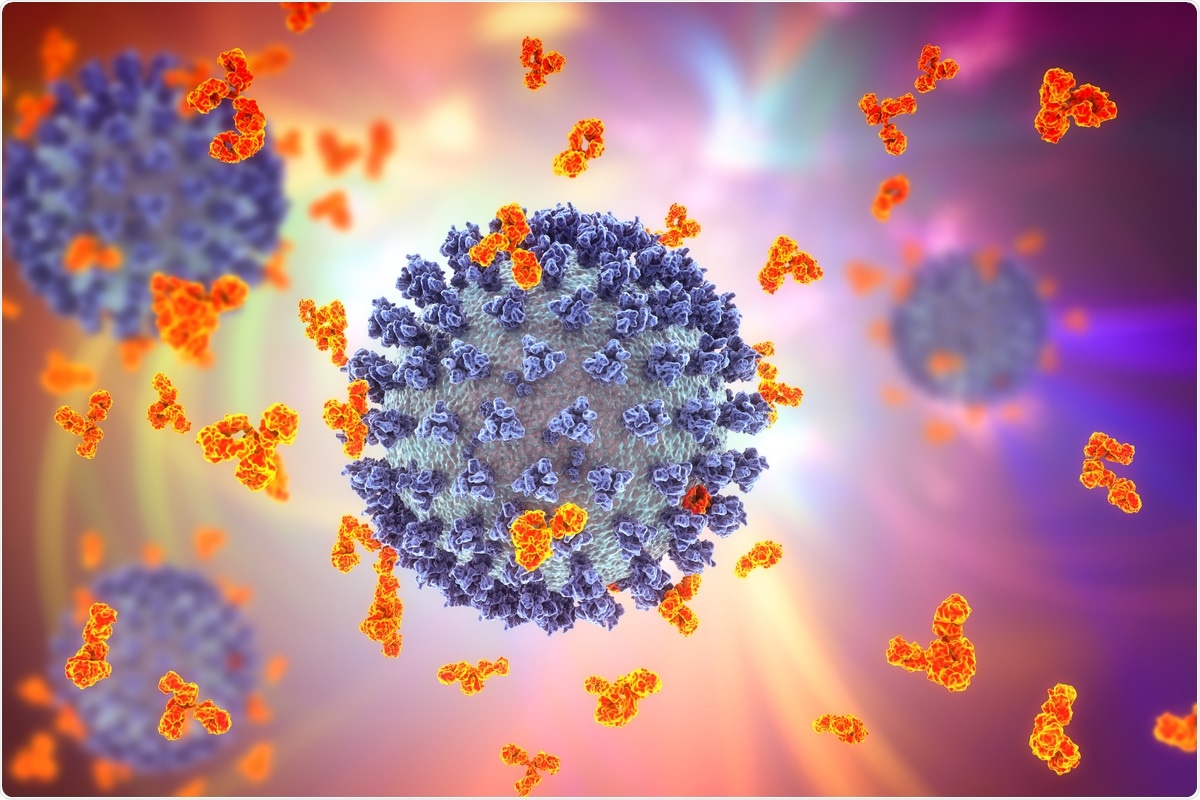It has been twenty months since the coronavirus disease 2019 (COVID-19) pandemic began, with 243 million people infected, 4.94 million deaths, and 6.3 billion vaccines doses administered.
 Study: Hybrid immunity improves B cells and antibodies against SARS-CoV-2 variants. Image Credit: Kateryna Kon/ Shutterstock
Study: Hybrid immunity improves B cells and antibodies against SARS-CoV-2 variants. Image Credit: Kateryna Kon/ Shutterstock
Many studies have thus far shown that protection from infection is linked to the production of neutralizing antibodies against the spike (S) protein of severe acute respiratory syndrome coronavirus 2 (SARS-CoV-2). The spike protein is a metastable, trimeric class 1 fusion glycoprotein composed of the S1 and S2 subunits. It mediates virus entry into the host cells after binding to the human angiotensin-converting enzyme 2 (ACE2) receptor and heparan sulfates on the cell surface.
Potent neutralizing antibodies generated post-vaccination recognize the S1 subunit of each monomer, including the receptor-binding domain (RBD) and N-terminal domain (NTD) immunodominant sites. The majority of neutralizing antibodies have been shown to bind the receptor-binding motif (RBM) within the RBD, and a smaller fraction targets the NTD. Neutralizing antibodies against the S2 subunit have extremely low potency.
Since the delta variant is the main causative agent behind breakthrough infections among fully vaccinated individuals, it becomes imperative to understand the molecular mechanisms of the immune response to vaccination.
Researchers isolated single cells among individuals with and without prior infection with the SARS-CoV-2 vaccinated with BNT162b2 mRNA vaccine and compared the nature of the neutralizing antibody response against the original Wuhan virus and the subsequent variants. The study was published in the latest issue of Nature.
Study Details
Researchers enrolled ten donors vaccinated with the BNT162b2 mRNA vaccine, five of them were healthy people naïve to SARS-CoV-2 infection at the time of enrolment. At the same time, the other five had been exposed to the infection in the past and were convalescent.
Plasma analysis in these individuals showed sero-positives had a 2.46-fold increase in S protein-specific CD19+ CD27+ IgDIgM- Memory B Cells (MBC – crucial in providing humoral immunity) compared to sero-negatives and an overall increase in the level of CD19+ CD27+ IgDIgM- MBC by 10%. Plasma from seropositive individuals showed a higher binding activity to the S protein and all tested domains than seronegative individuals.
Cell sorting assays were used to isolate and analyze the neutralized antibodies (nAbs) post-vaccination. Almost six thousand cells were sorted. Over three thousand produced monoclonal antibodies against the spike protein, and more than four hundred neutralized the original Wuhan SARS-Coronavirus. Four hundred and eleven nAbs were isolated, of which 71 were derived from sero-negatives, and 340 were from sero-positives. The overall fraction of S protein-specific B cells producing nAbs was 7.5% for seronegative individuals and 14.8% for seropositive individuals.
Seropositive individuals had an overall higher percentage of nAbs neutralizing the mutants as compared to seronegative individuals. The average frequency of nAbs from seropositives neutralizing the alpha, beta and gamma variants was 80.6 (n=274), 39.4 (n=134) and 62.0% (n=211) respectively, compared to 70.4 (n=50), 22.5 (n=16) and 43.6% (n=31) respectively in seronegatives.
On further characterizing the breadth of coverage against variants by these nAbs, the seropositive individuals were seen to constitute 71.0%, 62.5%, 23.7%, 22.8%, 53,1% of the whole nAbs repertoire, while nAbs from seronegative donors were 48.1%, 38.5%, 17.3%, 17.3%, 34.6% against the Wuhan SARS-CoV-2 virus and alpha, beta, gamma and delta variants respectively.
Overall, the B.1.351 (Beta) and B.1.1.248 (Gamma) variants were shown to escape almost seventy percent of the neutralizing antibodies. At the same time, a much smaller portion was impacted by the B.1.1.7 (Alpha) and B.1.617.2 (Delta) variants. The overall loss of neutralization was always significantly higher in the antibodies from naive people. This was also partially due to the IGHV2-5; IGHJ4-1 germline, which was found only in convalescent people and generated potent and broadly neutralizing antibodies.
Study implications
This study showed that a third round of antibody generation in the body could better immunity against the most virulent SARS-CoV-2 variants. This implies that people without prior exposure to the virus may benefit greatly from a third round of vaccination. This would keep breakthrough infections at bay, help scientists formulate better, more potent vaccines, and help contain the disease.
- Andreano, E. et al. (2021) "Hybrid immunity improves B cells and antibodies against SARS-CoV-2 variants", Nature. doi: 10.1038/s41586-021-04117-7.
Posted in: Medical Science News | Medical Research News | Disease/Infection News
Tags: ACE2, Angiotensin, Angiotensin-Converting Enzyme 2, Antibodies, Antibody, Cell, Cell Sorting, Coronavirus, Coronavirus Disease COVID-19, Enzyme, Frequency, Germline, Glycoprotein, Immune Response, immunity, Pandemic, Protein, Receptor, Respiratory, SARS, SARS-CoV-2, Severe Acute Respiratory, Severe Acute Respiratory Syndrome, Spike Protein, Syndrome, Vaccine, Virus

Written by
Sreetama Dutt
Sreetama Dutt has completed her B.Tech. in Biotechnology from SRM University in Chennai, India and holds an M.Sc. in Medical Microbiology from the University of Manchester, UK. Initially decided upon building her career in laboratory-based research, medical writing and communications happened to catch her when she least expected it. Of course, nothing is a coincidence.
Source: Read Full Article